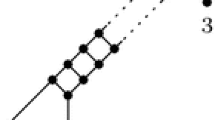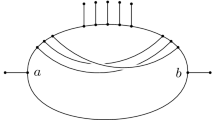Abstract
Phylogenetic networks generalise phylogenetic (evolutionary) trees by allowing for the representation of reticulation (non-treelike) events. The structure of such networks is often viewed by the phylogenetic trees they embed. In this paper, we determine when a phylogenetic network \({\mathcal {N}}\) has two phylogenetic tree embeddings which collectively contain all of the edges of \({\mathcal {N}}\). This determination leads to a polynomial-time algorithm for recognising such networks and an unexpected characterisation of the class of reticulation-visible networks.



Similar content being viewed by others
References
Bordewich M, Semple C (2007) Computing the hybridization number of two phylogenetic trees is fixed-parameter tractable. IEEE ACM Trans Comput Biol Bioinform 4:458–466
Bordewich M, Semple C (2016) Reticulation-visible networks. Adv Appl Math 78:114–141
Bordewich M, Semple C (2018) A universal tree-based network with the minimum number of reticulations. Discrete Appl Math. https://doi.org/10.1016/j.dam.2018.05.010
Cardona G, Rossello F, Valiente G (2009) Comparison of tree-child phylogenetic networks. IEEE/ACM Trans Comput Biol Bioinform 6:552–569
Cordue P, Linz S, Semple C (2014) Phylogenetic networks that display a tree twice. Bull Math Biol 76:2664–2679
Dagan T, Martin WF (2006) The tree of one percent. Genome Biol 7:118
Doolittle WF, Bapteste E (2007) Pattern pluralism and the tree of life hypothesis. Proc Natl Acad Sci USA 104:2043–2049
Francis AR, Steel M (2015) Which phylogenetic networks are merely trees with additional arcs? Syst Biol 64:768–777
Francis A, Semple C, Steel M (2018) New characterisations of tree-based networks and proximity measures. Adv Appl Math 93:93–107
Gambette P, van Iersel L, Kelk S, Pardi F, Scornavacca C (2016) Do branch lengths help locate a tree in a phylogenetic network? Bull Math Biol 78:1773–1795
Gunawan ADM, DasGupta B, Zhang L (2017) A decomposition theorem and two algorithms for reticulation-visible networks. Inf Comput 252:161–175
Hayamizu H (2016) On the existence of infinitely many universal tree-based networks. J Theor Biol 396:204–206
Hein J (1990) Reconstructing evolution of sequences subject to recombination using parsimony. Math Biosci 98:185–200
Jetten L, van Iersel L (2018) Nonbinary tree-based phylogenetic networks. IEEE ACM Trans Comput Biol Bioinform 15:205–217
Kanj I, Nakhleh L, Than C, Xia G (2008) Seeing the trees and their branches in the network is hard. Theor Comput Sci 401:153–164
Nakhleh L, Jin G, Zhao F, Mellor-Crummey J (2005) Reconstructing phylogenetic networks using maximum parsimony. In: IEEE computational systems bioinformatics conference, pp 93–102
Semple C (2016) Phylogenetic networks with every embedded phylogenetic tree a base trees. Bull Math Biol 78:132–137
Semple C (2017) Size of a phylogenetic network. Discrete Appl Math 217:362–367
Song Y, Hein J (2003) Parsimonious reconstruction of sequence evolution and haplotype blocks: finding the minimum number of recombination events. In: Benson G, Page R (eds) Algorithms in bioinformatics (WABI), Lecture notes in bioinformatics, vol 2812, pp 287–302
van Iersel L, Semple C, Steel M (2010) Locating a tree in a phylogenetic network. Inf Process Lett 110:1037–1043
van Iersel L, Kelk S, Lekić N, Whidden C, Zeh N (2016) Hybridization number on three rooted binary trees is EPT. SIAM J Discrete Math 30:1607–1631
Zhang L (2016) On tree-based phylogenetic networks. J Comput Biol 23:553–565
Author information
Authors and Affiliations
Corresponding author
Additional information
Charles Semple was supported by the New Zealand Marsden Fund.
Rights and permissions
About this article
Cite this article
Semple, C., Simpson, J. When is a Phylogenetic Network Simply an Amalgamation of Two Trees?. Bull Math Biol 80, 2338–2348 (2018). https://doi.org/10.1007/s11538-018-0463-x
Received:
Accepted:
Published:
Issue Date:
DOI: https://doi.org/10.1007/s11538-018-0463-x




